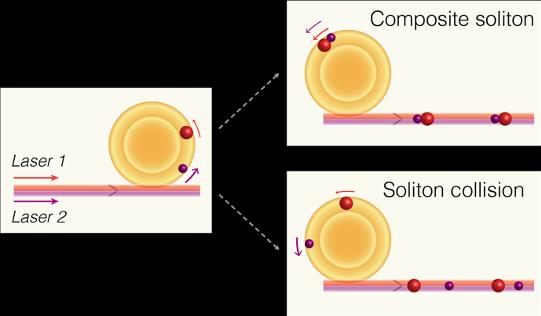
Credit: Weng Wenle/EPFL
Solitons are self-reinforcing particle-like wave packets enabled by the balance between dispersion and nonlinearity. Occurring in hydrodynamics, lasers, cold atoms, and plasmas, solitons are generated when a laser field is confined in a circular resonator with ultra-low loss, which produces multiple solitons travelling around the resonator.
Normally, these solitons travel with the same speed, so they rarely get close to each other. However, when solitons do collide into each other, they can reveal important fundamental physics of the system, including the properties of the host resonator and its nonlinearity. What this means is that demonstrating and controlling soliton collisions in optical microresonators is a major goal for researchers in nonlinear dynamics and soliton physics.
Published in Physical Review X, researchers at Tobias Kippenberg’s lab at EPFL have now developed a novel and effective method for generating soliton collisions in microresonators. The approach uses two lasers to generate two different soliton species – each species has a unique traveling speed – in a crystalline whispering gallery mode resonator.
The researchers input two laser fields in the microresonator, driving two soliton species whose speed mismatch can be flexibly controlled. As a result, solitons with different speeds collide into each other.
Depending on the difference between the solitons’ speeds, different solitons can either bind with each other after they collide or cross each other. Since each collision happens in a very short time, conventional techniques cannot resolve individual soliton behaviors.
Here the researchers used a pulse train produced by high-speed modulators to probe the solitons. The interference between the pulses and the solitons generates electronic signals that can be recorded and analyzed, allowing the researchers to compare the results with theoretical simulations that accurately predict the experimental observations.
This phenomenon shows how robust these solitons in optical microresonators can be. “During the soliton collision an individual soliton’s shape can be significantly distorted, and its energy exhibits dramatic vibrations,” explains Wenle Weng, the paper’s first author. “Yet, they can survive the strong impact from the collision, and they can unite with or disengage from each other after the collision.”
The work introduces a convenient yet powerful platform to study complex soliton interactions and transient nonlinear dynamics. But it can also have help generate synchronized frequency combs and soliton-based optical telecommunications. The collision and binding mechanisms can be utilized to construct frequency combs with unconventional structures for optical metrology, and to enhance the bandwidth of frequency combs in general.
###
Reference
Wenle Weng, Romain Bouchand, Tobias J. Kippenberg. Formation and collision of multistability-enabled composite dissipative Kerr solitons. Physical Review X, 23 April 2020. DOI: 10.1103/PhysRevX.10.021017
Contact
Professor Tobias J. Kippenberg
+41 21 69 34428, +41 21 69 34452
Email: [email protected]
Media Contact
Nik Papageorgiou
[email protected]
Related Journal Article
http://dx.




